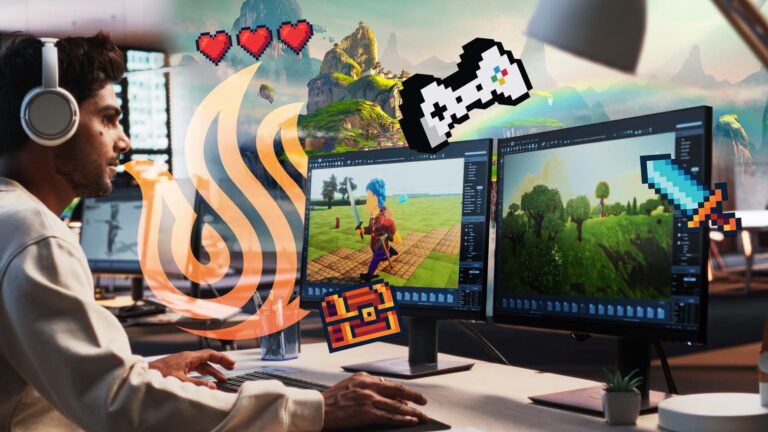
Game Design is a career choice that is becoming more popular. New technology is introduced at a cheaper cost and the audience for gaming has grown from a small group of enthusiasts to nearly every demographic available. Over half of all Americans play some form of video game whether that be on the phone, computer or console. There are also billions of gamers that exist across the whole world.
The video game market is growing to allow people to play any game anywhere. Video games are also becoming more accessible and representative of people. There are new ways of gaming being invented constantly and game designers are always raising the bar for creativity, when it comes to the different aspects of what makes a video game.
The best part about being a game designer is there is a near infinite means of expressing oneself. Very few game designers create the entirety of a video game, very often the work is split between graphics, audio, narrative and game play. However, sometimes one person can do a combination of the work. Video games allow a game designer to express themselves through a combination of interactive action, immersive audio and graphics that simulates a feeling not offered by other mediums.
The Role of “Immersion”
The concept of immersion can be a hard concept to comprehend as the amount of immersion one might find in a game will vary. The word is also misleading as it applies that immersion can only come from realistic games however this is not the case. Every game has a specific goal that the game designers intended for their audience. There is no wrong way to play a game if one is having fun. However, the game designers intended for the player to engage with the game on their terms and also intend their audience to take something away from the experience.
Current video games are becoming more impressive in their ability to tell engaging and moving narratives. This long-lasting impression inherent only to video games is the result of the game designer properly immersing a player into the game and having them thoroughly suspend themselves. Movies and television are capable of suspending the mind of an audience, but video games offer an audience a way to directly engage and be involved in the action. That is a much more engaging experience than just observing. Depending on the goal of a game, the methods of immersion are different. A good example exists in horror games and “choose your own” adventure games. In horror games apart from scary graphics and creepy audio, game designers leave the player helpless or unarmed to impart the terror of being overwhelmed. “Choose your own” adventure games were once simple point and click games, but now they have expanded to many different genres like shooters, and open world adventure games. These games allow the player to make observable differences in the world and feel the consequences of their actions. If a player knows that their favorite characters mortality is in their hands it adds weight to their decisions and will affect how that players plans their missions.
There are countless stories of players befriending unlikely in-game characters and going to lengths to save them from doomed fates. Emergent game play is a term used for game play that emerges from different game play systems, programmed to interact. A good example of emergent game play is roaming beasts or animals in a video game randomly entering a fight and surprising a player. These moments can be scripted but often the most immersive games have seamless game play systems that interact in a balance of dynamic and predictable.
Designing Controls for Video Games
One of the most sacrosanct rules of video games is that they must be “fun.” Just like immersive, this can be a hard concept to conceive as it too is subjective. One common thread between “fun” video games is that the controls from them elicit some sort of euphoria. Some games may appear somewhat simple on the surface but can be surprisingly addictive or engaging. The Mario series can be difficult in some sections, but the game is more known for its smooth controls. Skating games often reward technical skill from controller input and players can experience a sort of Zen as their fingers dance between the different buttons to pull of an impressive trick.
If a video game doesn’t control well or is sluggish, it isn’t always the worst case, but it will make it hard for players to feel like they are having a good time. Games don’t always need to offer instant gratification however players should feel like the buttons or input they are given does something to progress the game. Many games now let players change their controls to help in the case of a disability or even just for comfort.
Most games today try to minimize the player’s time in menus, where the player doesn’t want to spend their time, to facilitate the best experience possible. Some inventive games use of only one or two buttons, manage to find a way to make that interesting and addicting. Super Hexagon is a game by the game designer Terry Cavanaugh where the only input the player has is to orbit a cursor around a central hexagon and avoid oncoming walls. This is all done by simply rotating either the mouse or two arrows keys. Despite the simplicity, the game is significantly challenging which fuels a further desire to play.
Many find competition to be the reason they like gaming and mastering the controls of a video game and using it to defeat opponents can be exhilarating. There are various ways to compete online from first person gunfights with tight and very impulse based controls, to slow paced often third person strategy games where players command a team or army to defeat other players forces. There are even simulations of every sports games imaginable and fictitious or embellished sports games like fighting games. The most popular of all of these tend to be games with very responsive controls that allow a player complex and dynamic fighting or competitive action against their opponent.
How to Display and Direct a Game
Displaying and directing a game is one of the final steps of game production. After game designers find an engaging or fun control scheme, matched with some sort of immersive setting, they can think of the graphical and audio components that tie everything together into a video game. Realistic graphics are becoming possible with faster computing methods. Realistic graphics are great for simulation or physics-based games as they give the player the indication that this world works similarly to real life. An example of where realistic graphics is appropriate include puzzle or action games that require the player to think as if they were acting in place of the video game.
Most games don’t need to be fully realistic but will bend the art style to be a mixture of realistic and embellished. A sci fi game in space might use high-resolution detailed textures but also be a little liberal both with an expressive art-style as well as some unrealistic physics. Games that use a somewhat realistic art style are trying to keep at least something familiar for the player in order to meet or subvert their expectations. Artists might use a mixture of completely generated images as well as edited photos to achieve a familiar yet unfamiliar look for players. A game designer may completely forgo realism in order to achieve a more expressive or artistic look. They might make a game look like it was hand painted or being played on an older computer in order to achieve a technical or narrative effect. Some games also choose to have a cartoon look that will often fit with a game that does not control even remotely like real life and is just pure fantasy.
Depending on the intention as well as the goal of the game, different graphics will give the game a different feeling and game designers will spend a lot of time finding the right mood required. Audio designers are often required to find sound effects for the many in game objects. If a game has an advance physics system, it may require sound effects to be made for different object collisions often with different variations of materials for more immersive effects.
A technical artist is someone who combines their expertise in art and programming to create various digital effects. Graphics and audio are the means for which players interact with the narrative. Apart from 3D models of locations and characters, game designers also have to create menus and user interfaces that read well for whatever the player is doing. It might be hard for a player to read a complicated or busy user interface while they are busy with an intense battle, so game designers create sleek and adaptable interfaces that show only what is needed at any given time.
Conclusion
Starting a career in video game design can be a way to express oneself in a dynamic and creative way. The possibility for creating unique experiences can vary from the literal to the extremely meta with games seeming to be more self-aware. The context of interacting with a video game makes it easier to make referential or meta work. It is possible to create worlds that are familiar or inspired from others or to create entirely new ways to play.
Video games allow people to do the impossible on their own time and in their own space often using their own creativity. Creating these experiences for others is one of the most interesting jobs for a game designer. Game design is a career anyone interested in computers should consider especially with programming becoming a more demanded skill. Game design combines artistry as well as technical computer knowledge and it is a perfect career for any modern artist or computer programmer.
Did learning about game design as a new artform for expression interest you? Code is the lifeblood that fuels every gameplay experience, so buff your technical skills as you learn to design and program video games in the Game Design Engineering degree program. Modify existing game engines before moving on to designing your own, forming the systems that power gaming’s greatest experiences. This includes implanting animation, AI and computer graphics within an engine. You’ll develop a project plan that will get others excited about turning video game design concepts into fleshed-out games with characters, worlds and objectives. You’ll be able to take a role as game designer and/or engineer, on teams structured to mirror those in professional game development.
University of Silicon Valley is uniquely poised to offer a meaningful and valuable education for 21st century students. We believe in an education that directly correlates with the work you’ll be doing after you graduate. Interested in learning more? Contact Us today.


